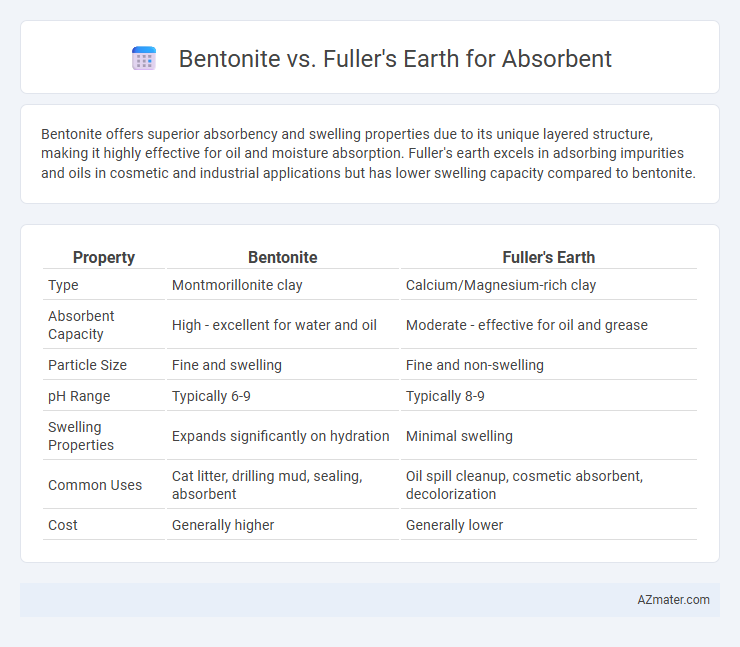Bentonite offers superior absorbency and swelling properties due to its unique layered structure, making it highly effective for oil and moisture absorption. Fuller's earth excels in adsorbing impurities and oils in cosmetic and industrial applications but has lower swelling capacity compared to bentonite.
Table of Comparison
| Property | Bentonite | Fuller's Earth |
|---|---|---|
| Type | Montmorillonite clay | Calcium/Magnesium-rich clay |
| Absorbent Capacity | High - excellent for water and oil | Moderate - effective for oil and grease |
| Particle Size | Fine and swelling | Fine and non-swelling |
| pH Range | Typically 6-9 | Typically 8-9 |
| Swelling Properties | Expands significantly on hydration | Minimal swelling |
| Common Uses | Cat litter, drilling mud, sealing, absorbent | Oil spill cleanup, cosmetic absorbent, decolorization |
| Cost | Generally higher | Generally lower |
Introduction to Absorbents: Bentonite and Fuller’s Earth
Bentonite and Fuller's Earth are highly effective absorbents widely used in industrial and environmental applications due to their unique clay mineral compositions. Bentonite primarily consists of montmorillonite, known for its remarkable swelling capacity and exceptional absorption of liquids, making it ideal for sealing and contaminant containment. Fuller's Earth, rich in hydrous aluminum silicates, excels in oil absorption and decolorization processes, highlighting its critical role in environmental cleanup and refining industries.
Chemical Composition and Structure Comparison
Bentonite primarily consists of montmorillonite, a smectite group clay mineral with a layered structure that allows high swelling capacity and excellent absorbent properties due to its cation exchange capacity. Fuller's earth is mainly composed of hydrous aluminum silicates, typically containing palygorskite and/or attapulgite minerals, which provide a fibrous structure enhancing oil absorption but with less swelling than Bentonite. The chemical composition of Bentonite (rich in sodium and calcium ions) contrasts with Fuller's earth's higher aluminum content, influencing their differential absorption mechanisms and applications in environmental remediation and cosmetic industries.
Absorption Mechanisms: How Bentonite and Fuller’s Earth Work
Bentonite absorbs fluids through its unique layered structure and high cation-exchange capacity, allowing it to swell and trap water molecules within its interlayers. Fuller's earth primarily absorbs oils and impurities via its porous, fine-grained clay particles that physically adsorb contaminants on their surfaces. Both clays rely on their mineral composition--bentonite's montmorillonite and fuller's earth's palygorskite and attapulgite--to capture and retain different types of substances effectively.
Key Physical Properties: Texture, Particle Size, and Color
Bentonite exhibits a fine, clay-like texture with particle sizes typically ranging from 0.1 to 2 microns, characterized by its grayish-white to cream color, making it highly efficient for absorbing liquids due to its swelling properties. Fuller's earth has a slightly coarser texture with particle sizes between 2 and 20 microns and presents a pale yellow to light brown color, offering good absorbency through its porous structure but less swelling capacity compared to Bentonite. The smaller particle size and high plasticity of Bentonite enhance liquid retention, whereas Fuller's earth excels in absorbing oils and greases due to its adsorptive surface area.
Effectiveness in Oil, Grease, and Chemical Spill Absorption
Bentonite exhibits superior absorbency due to its high swelling capacity and layered structure, making it highly effective in oil, grease, and chemical spill absorption. Fuller's earth, composed mainly of hydrous aluminum silicates, offers moderate absorption with enhanced oil-binding properties but lower chemical spill resistance. For industrial applications requiring rapid containment of diverse contaminants, Bentonite provides a more robust solution in spill remediation.
Environmental Impact and Sustainability
Bentonite and Fuller's earth both serve as effective absorbents, but Bentonite offers a lower environmental impact due to its abundant natural deposits and minimal processing requirements, resulting in reduced carbon emissions. Fuller's earth extraction often involves more intensive mining practices that can disrupt local ecosystems and increase energy consumption, posing challenges for sustainability. Choosing Bentonite supports eco-friendly applications by promoting resource efficiency and minimizing habitat disturbance in absorbent production.
Safety Considerations: Handling and Usage
Bentonite and Fuller's earth both exhibit high absorbency, but Bentonite is generally preferred for applications requiring food-grade or pharmaceutical safety due to its lower potential for heavy metal contamination. Fuller's earth, while effective in industrial absorbent uses, may contain impurities that necessitate strict handling protocols to avoid skin irritation and respiratory issues. Proper personal protective equipment (PPE) such as gloves and masks should be used when handling either clay to minimize inhalation of dust and prevent direct skin contact.
Cost and Availability in the Market
Bentonite offers a cost-effective solution with widespread availability, making it a preferred absorbent in many industrial and environmental applications. Fuller's earth tends to be more expensive due to its unique purification properties but is less abundant in the market, limiting large-scale usage. Choosing between Bentonite and Fuller's earth depends on budget constraints and the specific absorbent efficiency required for the application.
Industrial and Household Applications
Bentonite and Fuller's earth are both highly effective absorbents widely used in industrial and household applications due to their exceptional adsorption capacities. Bentonite, composed mainly of montmorillonite clay, excels in absorbing oils, chemicals, and moisture, making it ideal for drilling muds, sealing, and wastewater treatment. Fuller's earth, rich in hydrous aluminum silicates, is preferred for purifying oils, decolorizing, and as a cat litter absorbent due to its superior grease and odor absorption properties.
Choosing Between Bentonite and Fuller’s Earth: Which Is Better?
Bentonite offers superior absorption due to its high swelling capacity and layered structure, making it ideal for applications like cat litter and industrial spill cleanup. Fuller's earth, composed mainly of clay minerals, provides moderate absorption with additional benefits in oil and water filtration due to its adsorptive properties. Choosing between Bentonite and Fuller's earth depends on the specific absorption needs and application context, with Bentonite favored for maximum fluid retention and Fuller's earth preferred for selective oil absorption and refining processes.

Infographic: Bentonite vs Fuller’s earth for Absorbent
 azmater.com
azmater.com